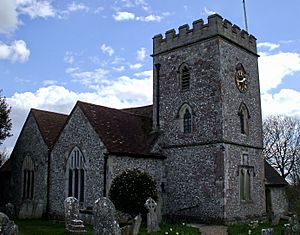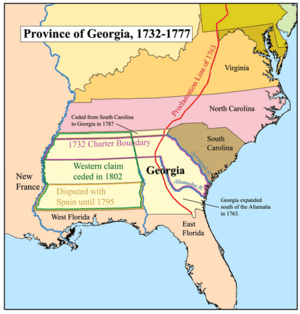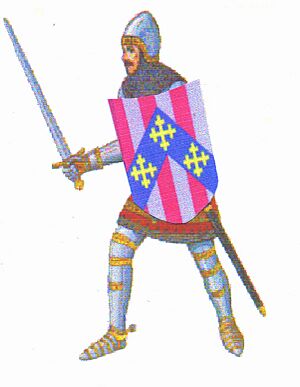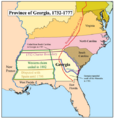George Carpenter, 2nd Baron Carpenter facts for kids
Quick facts for kids
The Lord Carpenter of Killaghy
|
|
|---|---|

St Andrews, Owlesbury, where Carpenter was buried
|
|
| Member of Parliament for Weobley |
|
| In office 1741–1747 |
|
| Member of Parliament for Morpeth |
|
| In office 1717–1727 |
|
| Personal details | |
| Born | 1695 Ocle Pychard, Herefordshire, England |
| Died | 12 August 1749 (aged 54) Grosvenor Square, London |
| Resting place | Owslebury |
| Political party | Whig |
| Spouse |
Elizabeth Petty
(m. 1722) |
| Children | George; Alicia |
| Parents | George Carpenter, 1st Baron Carpenter Alice Caulfield |
| Occupation | Politician and landowner |
| Military service | |
| Allegiance | |
| Rank | Lieutenant-Colonel |
| Unit | Life Guards |
George Carpenter, the 2nd Baron Carpenter, was an important English landowner and politician. He was a Member of Parliament (MP) at different times between 1717 and 1747. He also held the rank of Lieutenant-Colonel and was a member of the famous Royal Society.
Contents
Early Life and Family
George Carpenter was born in 1695 in Ocle Pychard, England. He was the only son of George Carpenter, the 1st Baron Carpenter, and Alice Caulfield.
In August 1722, George Carpenter married Elizabeth Petty. They had two children who grew up: a son named George and a daughter named Alicia. Both children made very good marriages. His son, George, became the Earl of Tyrconnell. His daughter, Alicia, became a Lady of the Bedchamber to Queen Charlotte. She also married the Earl of Egremont, who was a powerful Secretary of State from 1761 to 1763.
His Career and Public Service
George Carpenter held several military ranks in his father's regiment, the 3rd The King's Own Hussars. He became a Lieutenant at age 13 in 1708 and a Captain in 1712. However, it seems he did not actively serve in these roles. In those days, military ranks could be bought or used as investments. People often paid others to do their duties for them.
In 1715, he became a captain in the 1st Foot Guards. Then, in 1730, he was made Lieutenant-Colonel in the Life Guards. Again, these roles did not require him to be an active soldier.
Political Life
Carpenter was a member of the Whig political party. He served as a Member of Parliament (MP) for Morpeth from 1717 to 1727. After inheriting his cousin's estate in 1733, he later became the MP for Weobley from 1741 to 1747.
In June 1729, he was made a Fellow of the Royal Society. This is a very old and respected group for scientists. In 1737, he shared a story with the Society about his father. A musket ball had been stuck in his father's throat for almost a year after a battle!
The Georgia Colony
In 1732, George Carpenter was chosen as one of the Georgia Trustees. This group was created to start the Province of Georgia in North America. Georgia was the last of the Thirteen Colonies set up by Britain.
The idea for Georgia came from James Oglethorpe. It was meant to be a helpful project, but it struggled to get enough money. Eventually, the British Crown took over the colony in 1752. Carpenter played a smaller part in this project. He left the group in 1738, rejoined in 1739, and then left again in 1740. When the town of Brunswick, Georgia was founded in 1738, "Carpenter Street" was named after him.
Later Life
George Carpenter became the 2nd Baron Carpenter in 1731 after his father passed away. This was an Irish peerage, which meant he could still be a member of the House of Commons in England.
In 1733, he inherited a large estate called The Homme in Dilwyn, Herefordshire. He died on July 12, 1749, in Grosvenor Square, London. He was buried in his family's burial place at St Andrews, Owlesbury.
Coat of Arms
The Carpenter family's Arms seem to have come from France or Normandy. The main design is "Paly of six, argent and gules, on a chevron azure, 3 cross crosslets or." This means it has six vertical stripes of silver and red, with a blue V-shape on top that has three small gold crosses.
The family's motto is "Per Acuta Belli," which means "Through the Asperities of War." These arms are often called the Hereford arms, named after the Carpenter family's ancestral home in Hereford, England. The crest (the symbol above the shield), supporters (figures holding the shield), and motto have changed over many centuries.
These Hereford Arms were used by John Carpenter, the younger, who was an important Town Clerk of London in the 1400s. Later members of the family, like Sir William Boyd Carpenter (a Bishop) and his grandson John Boyd-Carpenter, Baron Boyd-Carpenter (a politician), also used these arms.
Images for kids






